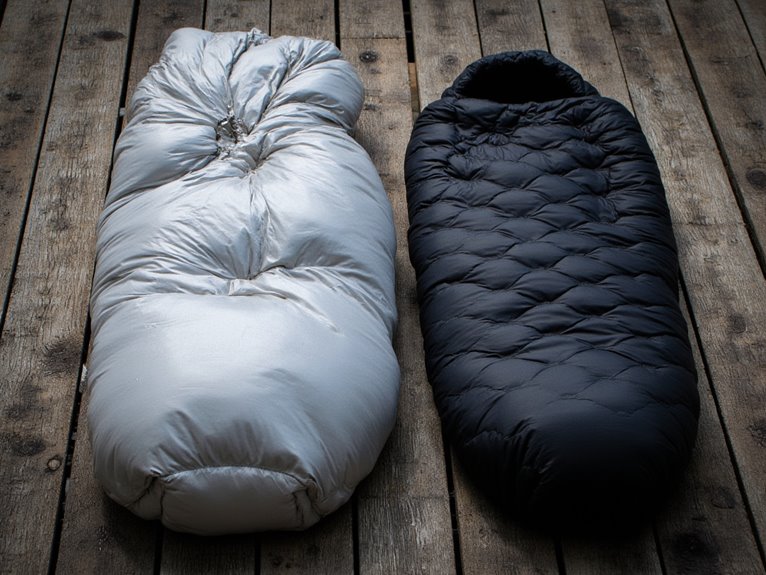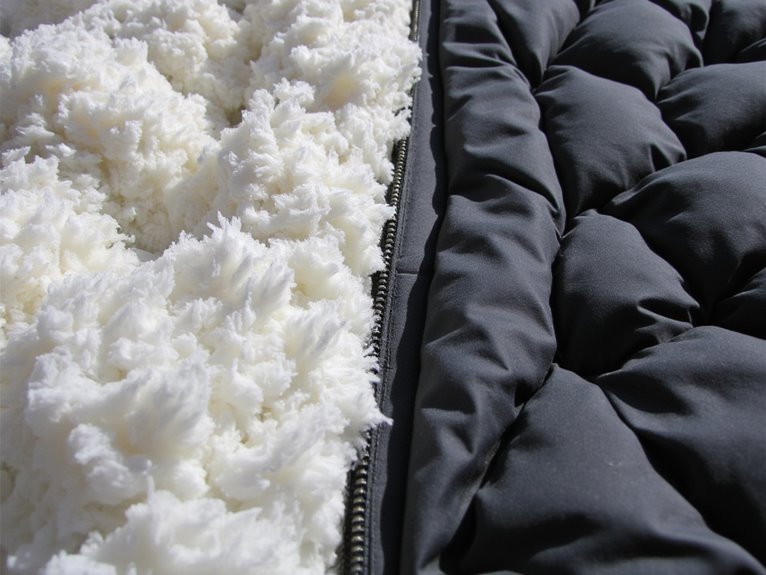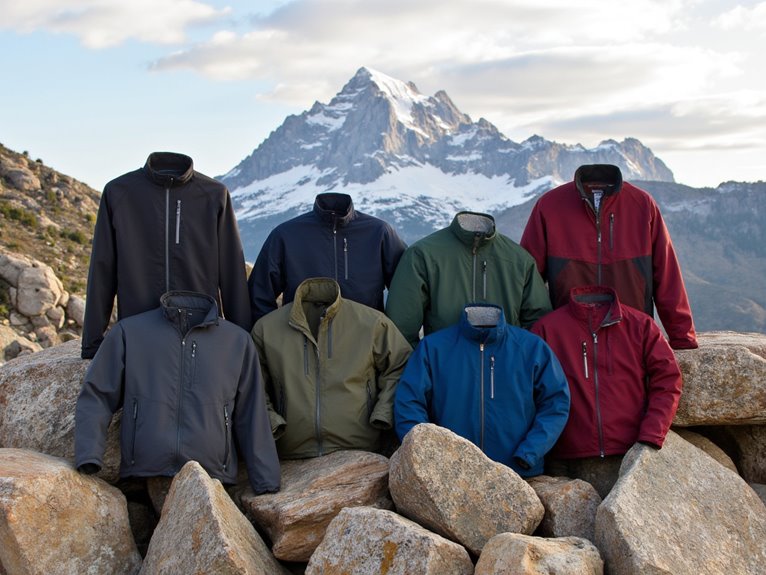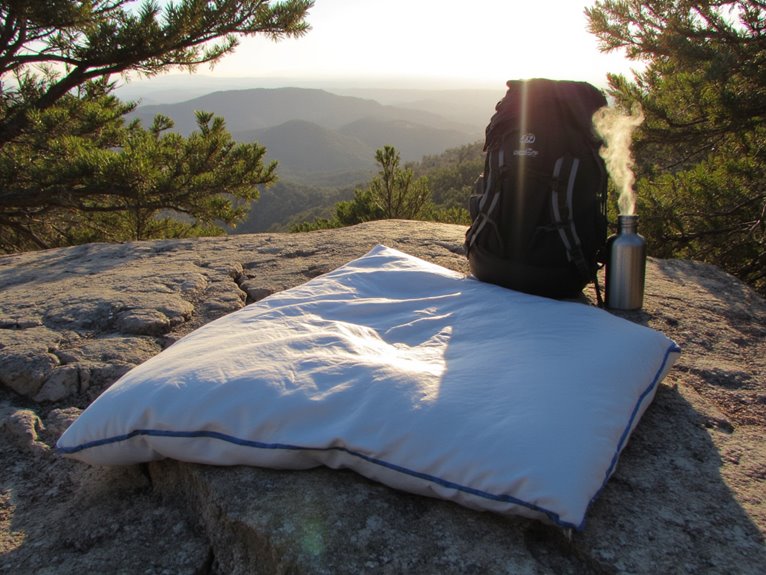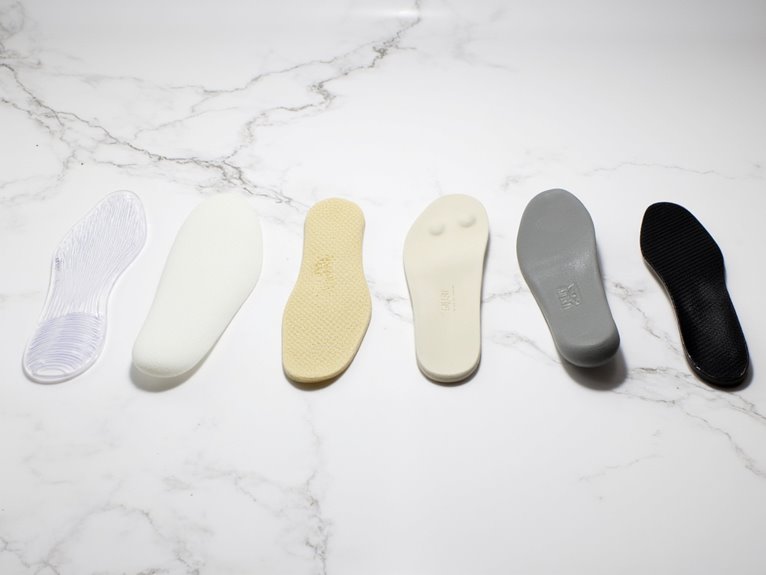Down Vs Synthetic Sleeping Bag
You’ll choose between down and synthetic sleeping bags based on three key factors: weight, moisture resistance, and budget. Down bags weigh 20-30% less, compress to half the size, and last 10-50 years, but they cost $300+ and lose 90% insulation when wet. Synthetic bags retain 70-80% warmth when damp, dry in 2-3 hours, and start under $200, though they’re heavier and last only 3-5 years. Understanding these trade-offs will guide your best selection.
We are supported by our audience. When you purchase through links on our site, we may earn an affiliate commission, at no extra cost for you. Learn more. Last update on 24th October 2025 / Images from Amazon Product Advertising API.
Notable Insights
- Down sleeping bags offer superior warmth-to-weight ratios and compress 30-50% smaller than synthetic alternatives for backpacking.
- Synthetic insulation retains 70-80% warmth when wet, while down loses 90% insulation power in moisture.
- Down bags last 10-50 years with proper care, compared to synthetic bags lasting only 3-5 years.
- Synthetic sleeping bags are more budget-friendly and easier to maintain than down bags requiring specialized cleaning.
- Down excels in cold, dry conditions while synthetic performs better in humid, wet environments.
Material Composition and Construction
When choosing between down and synthetic sleeping bags, understanding their material composition and construction differences is crucial for making an informed decision.
Down insulation comes from geese or ducks, offering superior warmth-to-weight ratios and compressibility. Fill power ranges from 600 to 900, directly affecting thermal efficiency. Down bags use baffle design systems that prevent insulation migration while maintaining loft.
Down’s exceptional fill power and baffle construction deliver unmatched warmth-to-weight performance for serious outdoor enthusiasts.
Synthetic insulation uses polyester fibers engineered to mimic down’s properties. These bags employ quilting construction instead of baffles, securing the synthetic fill through stitched patterns. The fiber staple length affects both insulation feel and overall performance characteristics. Advanced synthetic bags utilize concertina construction that maximizes air trapping layers for enhanced thermal efficiency.
Both types feature ripstop nylon or polyester outer shells with DWR coatings for moisture protection. Chamber design creates individual insulation zones in both constructions. Seam sealing prevents cold air infiltration, while specialized zippers guarantee reliable operation in harsh conditions.
Weight and Packability Comparison

When you’re choosing between down and synthetic sleeping bags, weight and packability become critical factors that directly impact your outdoor experience.
Down sleeping bags consistently outperform synthetic alternatives in both categories, typically weighing 20-30% less at comparable temperature ratings while compressing to half the packed volume.
You’ll find that a quality down bag rated for three-season use often weighs under 2 pounds and stuffs into a compression sack the size of a football.
Whereas synthetic bags require larger pack space and carry additional weight that adds up over long distances.
The difference becomes even more pronounced with premium goose down, which offers superior fill-power ratings compared to duck down alternatives.
Down insulation has a superior warmth-to-weight ratio compared to synthetic, making it the preferred choice for serious backpackers who prioritize performance over cost.
Modern compression sacks can reduce packed size by up to 40%, enabling even bulkier synthetic bags to achieve more manageable dimensions for transport.
Down Weight Advantage
Down sleeping bags consistently outperform synthetic alternatives in weight and packability metrics.
You’ll find that down filling provides superior warmth-to-weight ratios compared to other insulation types.
Higher fill power down creates lighter products since less material achieves equivalent thermal performance.
Key weight advantages include:
- Fill power efficiency – 800+ fill power down weighs markedly less than 600 fill power for identical warmth ratings
- Material density – Down compresses to half the volume of synthetic insulation when packed
- Fabric integration – Lighter shell fabrics pair naturally with down’s minimal bulk requirements
- Construction benefits – Fewer baffles needed due to down’s superior loft properties
- Long-term consistency – Down maintains weight advantages throughout its extended lifespan
Synthetic insulation requires nearly double the material weight to match down’s thermal efficiency, making down the clear choice for weight-conscious backpackers. Most sleeping bags with down insulation weigh between 2 and 4 pounds, which represents the lighter end of the sleeping bag weight spectrum. Modern synthetic fills can also perform well in cold temperatures but generally cannot match down’s compressibility advantages.
Compression Space Savings
Space efficiency becomes critical when you’re planning multi-day backpacking trips where every cubic inch matters.
Down sleeping bags compress to approximately 30-50% smaller than equivalent synthetic bags. A 20-degree down bag typically packs to 6-8 liters, while synthetic versions require 10-14 liters. This space efficiency translates to more room for essential gear like food, water, and safety equipment.
Using compression tools amplifies these benefits. Compression sacks can reduce down bag volume by an additional 20-30%. High-fill power down (700-800+) offers the best compression ratios.
The superior compressibility stems from down’s ability to collapse into minimal space while retaining loft recovery. Synthetic insulation’s fiber structure prevents similar compression levels, making it bulkier for extended wilderness expeditions. Down bags typically weigh less and pack down smaller than synthetic bags of the same temperature rating.
Backpacking Portability Benefits
Beyond compression advantages, weight differences between down and synthetic sleeping bags create significant portability gaps that directly impact your hiking performance and gear capacity.
Down bags consistently deliver superior weight-to-warmth ratios, with 850+ fill power models weighing 1-2 pounds less than synthetic equivalents at identical temperature ratings.
This weight reduction translates into measurable backpacking benefits:
- Reduced pack weight enables longer daily distances and decreased fatigue
- Enhanced compression efficiency maximizes available storage space for essential gear
- Improved backpack organization through compact sleeping bag dimensions
- Lower overall carrying load reduces stress on joints and muscles
- Increased gear capacity allows space for additional safety equipment or food
High-quality down bags compress to one-third the size of synthetic alternatives, creating substantial space savings that experienced backpackers leverage for ideal load distribution. Premium down typically falls within the 650-900 ci/oz range, providing optimal loft properties for maximum compressibility. While synthetic bags offer advantages in wet conditions, proper waterproof storage using pack liners ensures down insulation maintains its superior portability characteristics.
Insulation Performance in Different Conditions
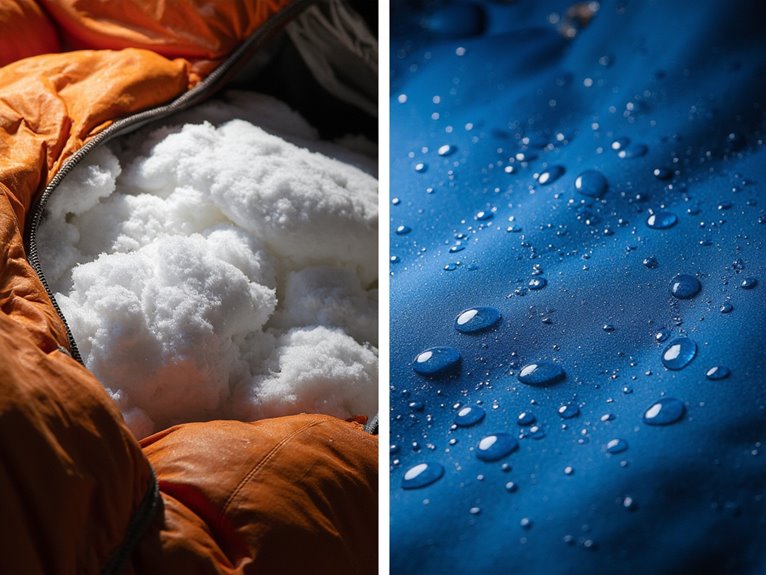
When you’re choosing between down and synthetic insulation, understanding how each performs across different environmental conditions becomes essential for your outdoor success.
These sleeping bag technologies exhibit distinct characteristics based on temperature and moisture levels.
Down insulation dominates in cold, dry conditions. Its high loft provides exceptional warmth retention, while superior insulation efficiency delivers unmatched warmth-to-weight ratios.
However, moisture dramatically reduces down’s performance when wet conditions compromise its loft structure.
Synthetic insulation maintains consistent warmth across varying climates. You’ll retain thermal protection even when nighttime perspiration or humidity affects your sleeping environment.
Synthetic materials resist moisture absorption, ensuring reliable performance during wet weather camping. Synthetic bags also dry faster than their down counterparts when exposed to moisture.
The insulation type you select significantly impacts overall warmth and packability for your specific outdoor adventures.
Climate adaptability favors synthetic insulation for unpredictable conditions, while down excels in stable, dry environments where maximum warmth-to-weight efficiency matters most.
Moisture Resistance and Wet Weather Performance
You’ll face critical performance differences between down and synthetic insulation when moisture becomes a factor in your outdoor adventures.
Down’s absorbent nature causes plumules to collapse when wet, losing up to 90% of insulation power, while synthetic materials maintain air pockets and retain warmth even when saturated.
Understanding how each insulation type handles wet conditions, recovery times, and humidity management will determine your comfort and safety in challenging weather environments.
Wet Insulation Performance
Water proves to be down insulation‘s greatest weakness, fundamentally altering its performance characteristics when moisture penetrates the sleeping bag.
When wet, down plumes clump together, eliminating the air pockets that create thermal barriers. This dramatically reduces insulation efficiency by up to 90% in saturated conditions.
Synthetic insulation maintains superior performance when exposed to moisture. The fibers retain their structure and continue providing warmth even when completely soaked.
However, wet synthetic bags still experience thermal mass effects that reduce overall warmth.
- Down loses loft immediately when wet, creating cold spots throughout the bag
- Synthetic fibers maintain 70-80% of their dry insulation value when saturated
- Water-repellent treatments on down provide temporary moisture protection
- Synthetic bags dry faster than down, typically within 2-3 hours
- Environmental considerations favor synthetic insulation in consistently humid climates
Drying Time Comparison
Drying speed becomes the determining factor in wet-weather recovery situations where your sleeping bag’s ability to regain thermal efficiency directly impacts safety and comfort.
Synthetic insulation dries overnight or during day breaks, while down requires multiple hours with external heat sources.
Down’s drying challenges stem from feather clumping and moisture retention, creating dense masses that resist airflow. You can wring out synthetic bags and achieve semi-effective insulation during the drying process.
Effective drying techniques vary dramatically between materials.
Synthetic fibers maintain structure when damp, allowing air circulation and faster evaporation.
Down becomes heavy and compact when saturated, requiring careful restoration of loft.
In prolonged wet weather or high humidity, synthetic gear offers consistent recovery performance while down remains compromised until thoroughly dried.
Humidity Management Capabilities
Two fundamental differences in fiber structure determine how down and synthetic sleeping bags handle moisture exposure.
Down clusters collapse when wet, eliminating insulating air pockets. Synthetic fibers maintain their structure and air gaps even when damp.
Humidity effects vary dramatically between these materials. Down absorbs ambient moisture, reducing loft and warmth. Synthetic insulation resists moisture absorption, preserving thermal performance in humid conditions.
Key moisture management differences:
- Down loses 80% insulation when wet vs. synthetic’s 10-15% loss
- Synthetic maintains air pockets when damp, down clumps together
- DWR treatments on down fade after 20-30 wash cycles
- Synthetic dries 3x faster than down in field conditions
- Down requires active ventilation management to prevent condensation buildup
Synthetic bags excel in unpredictable weather where moisture management becomes critical for safety and comfort.
Durability and Lifespan Analysis
When choosing between down and synthetic sleeping bags, understanding their durability differences can greatly impact your long-term investment and outdoor experience.
Down bags excel in longevity, lasting 10-50 years with proper care. High-quality down recovers loft after compression better than synthetic materials. However, sustainability concerns arise when down gets wet, losing insulating properties completely.
Synthetic bags typically last 3-5 years due to faster material degradation. The insulation technology in synthetic fills breaks down more rapidly under compression and moisture exposure. You’ll find synthetic bags retain warmth when wet, unlike down alternatives.
Cost analysis favors down long-term despite higher upfront investment. Synthetic bags require more frequent replacement, increasing lifetime costs.
Storage practices considerably affect both types—avoid compression for maximum lifespan regardless of fill material.
Many manufacturers now offer lifetime warranties on premium sleeping bags, reflecting confidence in their construction quality and providing added value for durability-conscious buyers.
Cost and Budget Considerations
Beyond durability considerations, your budget plays a major role in determining which sleeping bag type fits your needs.
Down bags typically start at $300, while synthetic options offer considerably lower entry points. This price comparison reveals that synthetic bags provide better value for occasional campers.
For weekend warriors and casual campers, synthetic sleeping bags deliver solid performance without the premium price tag of down alternatives.
- Down prices fluctuate due to bird flu outbreaks and fashion industry demand
- Synthetic insulation maintains stable pricing through manufactured materials
- Duck down offers cost savings over premium goose down options
- High-end synthetic bags can rival entry-level down performance
- Hybrid constructions blend materials at mid-range price points
Smart budget strategies include choosing synthetic for infrequent use or duck down for moderate performance needs.
Synthetic bags allow easier replacement and multiple purchases, while down’s superior warmth-to-weight ratio justifies higher costs for frequent backpackers.
Quality budget sleeping bags under $200 demonstrate that synthetic insulation can deliver reliable performance without compromising essential comfort features.
Maintenance and Care Requirements
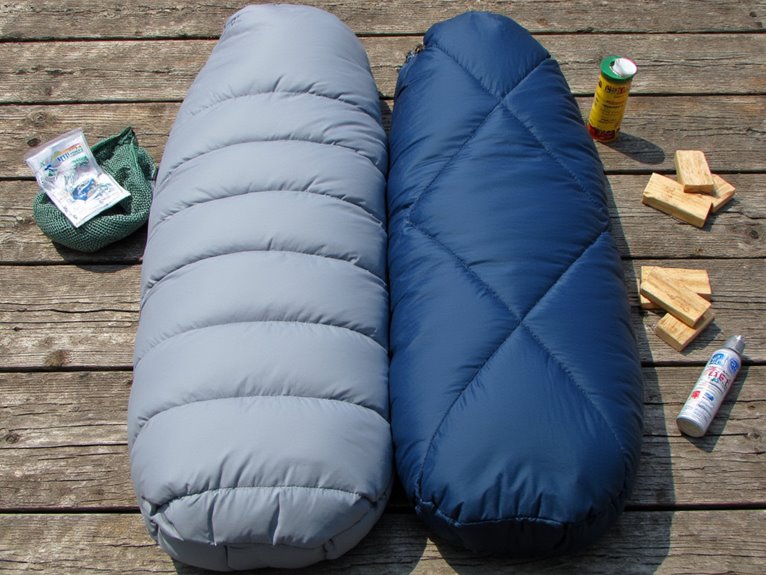
Your sleeping bag’s maintenance requirements differ considerably based on its insulation type, with down bags demanding more careful handling than their synthetic counterparts.
Down insulation requires specialized cleaning products and gentle washing techniques to preserve its loft and water-repellent properties, while synthetic fills tolerate standard detergents and more frequent washing cycles.
Understanding these care differences will extend your bag’s lifespan and maintain its thermal performance throughout years of use.
Down Care Essentials
Although down sleeping bags offer superior warmth-to-weight ratios, they’ll only maintain peak performance with proper care and maintenance protocols.
Down washing requires specialized techniques to preserve insulation properties. Use front-loading commercial washers with down-specific detergents like Nikwax Down Wash Direct. Complete two rinse cycles in warm water to eliminate detergent residue that damages down clusters.
Down drying demands low-heat tumble drying with tennis balls to restore loft. Check and rotate bags every 30 minutes to maintain even moisture removal.
Essential care protocols include:
- Turn bags inside out before washing and empty all pockets
- Never use fabric softeners or biological detergents
- Store uncompressed in large, breathable storage bags
- Apply down protectants for water resistance
- Inspect regularly for wear and maintain proper fill distribution
Synthetic Maintenance Tips
While synthetic sleeping bags don’t require the specialized care protocols that down demands, they’ll still deliver excellent performance and longevity when you follow proper maintenance routines.
Synthetic insulation maintains its temperature regulation properties even when damp, making these bags more forgiving during cleaning cycles.
You can wash synthetic bags more frequently than down without compromising performance. Use front-loading machines with specialized cleaners like Nikwax Tech-Wash. Rinse thoroughly to remove all cleaning agents. Support the entire bag when removing to prevent seam strain.
Air dry completely or tumble dry on low heat. Store uncompressed in breathable sacks away from direct sunlight. Check zippers regularly and inspect seams for wear.
Unlike down, synthetic fill won’t clump, but verify even distribution after washing for prime insulation performance.
Temperature Ratings and Seasonal Use
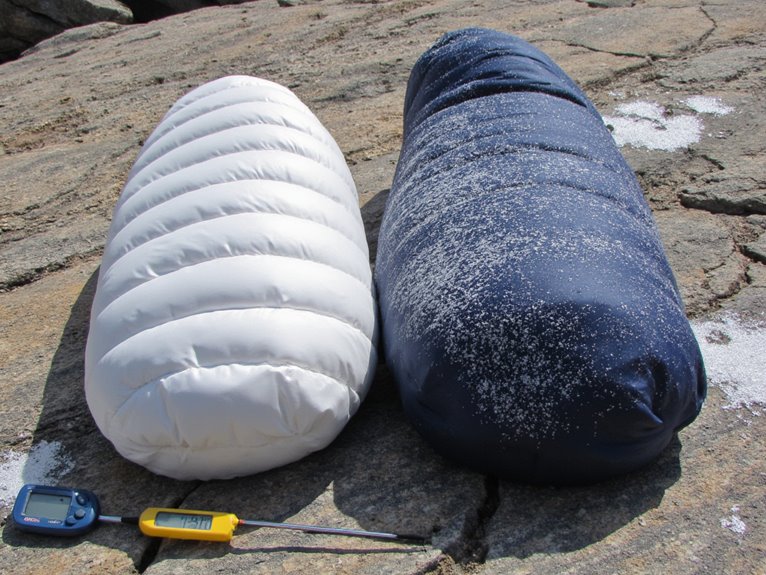
Understanding temperature ratings becomes critical when choosing between down and synthetic sleeping bags, as these standardized measurements directly impact your comfort and safety in varying conditions.
The EN/ISO 23537 standard provides three key ratings: comfort, limit, and extreme temperatures tested on thermal mannequins.
Down bags excel in cold, dry conditions with superior warmth-to-weight ratios.
You’ll find comfort ratings reaching -10°C while maintaining ultralight specs.
Synthetic bags perform better in damp environments, maintaining insulation when wet.
Key seasonal differences include:
- Winter expeditions favor down for maximum warmth efficiency
- Spring/fall conditions suit both types depending on moisture levels
- Wet coastal climates benefit from synthetic reliability
- Three-season models available in both materials with varying compressibility
- Extreme ratings exist for survival scenarios only
For optimal backpacking performance, select women’s sleeping bags with temperature ratings 10°F lower than expected conditions to ensure adequate warmth reserves during three-season adventures.
Environmental Impact and Sustainability
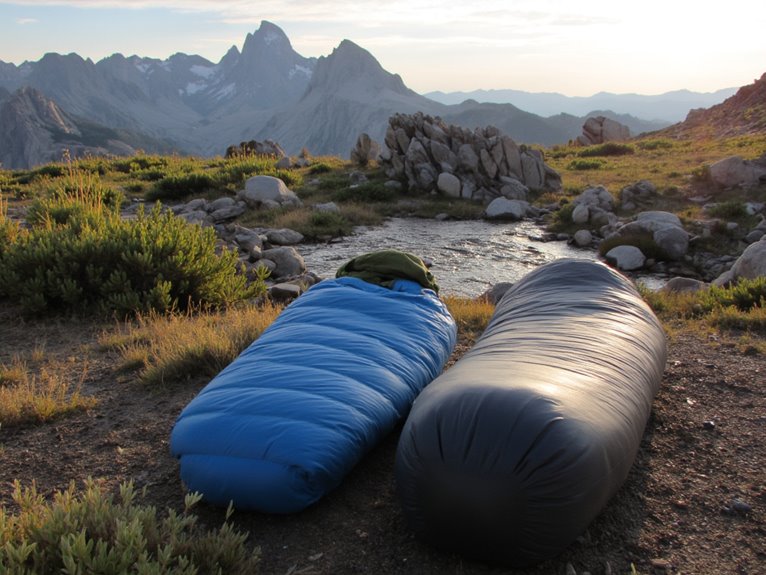
Beyond performance metrics and temperature ratings, your sleeping bag choice carries significant environmental consequences that extend far beyond the camping trip.
Down insulation demonstrates 18 times less climate impact than polyester fill according to Life Cycle Assessment studies. This natural material reduces environmental impacts by 85% to 97% across multiple categories compared to synthetic alternatives.
Down represents sustainable sourcing as a renewable byproduct from ducks and geese. Responsible Down Standard certification guarantees ethical procurement practices.
Meanwhile, eco friendly materials like recycled polyester can reduce emissions by 35% versus virgin synthetic fibers, though polyester production still requires energy-intensive processes and non-renewable resources.
Down’s biodegradable nature contrasts sharply with synthetic materials that persist indefinitely.
Your choice directly influences resource consumption, manufacturing emissions, and long-term waste generation.
Choosing the Right Sleeping Bag for Your Needs

Selecting the ideal sleeping bag requires evaluating five critical performance categories against your specific outdoor activities and environmental conditions.
Your choice between material types depends on prioritizing warmth-to-weight ratios versus moisture resistance.
The fundamental sleeping bag decision centers on whether you value maximum warmth efficiency or reliable performance in wet conditions.
Consider these key factors when choosing your sleeping bag:
- Climate conditions – Down excels in dry, cold environments while synthetic performs better in humid or wet conditions.
- Trip duration – Down’s superior durability makes it ideal for extended expeditions and frequent use.
- Pack weight limits – Down’s compressibility and lighter weight benefit ultralight backpacking.
- Budget constraints – Synthetic bags offer cost-effective entry points for recreational camping.
- Maintenance preferences – Synthetic insulation requires less specialized care and dries faster.
Match your sleeping bag material to your specific camping style and environmental demands for peak performance.
Frequently Asked Questions
Can I Mix Down and Synthetic Insulation in One Sleeping Bag?
You can absolutely mix down and synthetic insulation in one sleeping bag.
Hybrid insulation designs strategically place synthetic fill in moisture-prone areas like the footbox while using down in the torso section. This combination optimizes insulation performance by leveraging down’s superior warmth-to-weight ratio and synthetic’s moisture resistance.
Many manufacturers offer these dual-material bags, or you can layer a synthetic overquilt over your down bag.
Do Down Sleeping Bags Cause Allergic Reactions for Sensitive Users?
You can develop down allergies from sleeping bags containing feather proteins, dust mites, or manufacturing residues.
Insulation sensitivities affect people with existing allergies or asthma most severely. Symptoms include respiratory issues, skin irritation, and congestion during overnight exposure.
Properly cleaned down reduces allergen loads markedly. You’ll need synthetic alternatives if you’re highly sensitive, since even premium down retains some allergenic proteins despite thorough processing.
How Do Altitude Changes Affect Sleeping Bag Insulation Performance?
Altitude effects notably impact your sleeping bag’s insulation performance.
You’ll face colder temperatures due to lower atmospheric pressure and thinner air density. Your bag’s loft compresses more at elevation, reducing thermal efficiency by 10-15%.
Higher winds penetrate shell materials easier, creating convective heat loss. You’ll need bags rated 10-20°F below expected temperatures.
Down fill with 700+ cuin maintains better loft retention than synthetic options at altitude.
Can Sleeping Bags Be Repaired if Damaged During Outdoor Trips?
You can repair sleeping bags during outdoor trips using proper repair techniques.
Small tears require fabric patches or Tenacious Tape cut larger than the damage. Clean the area thoroughly and push fill away from the repair zone.
Apply adhesive to both surfaces and press from center outward. Effective bag maintenance includes carrying repair kits with patches, adhesive, and tape for immediate field fixes.
What Storage Methods Prevent Sleeping Bag Insulation From Losing Loft?
You’ll preserve your sleeping bag’s loft by avoiding compression bags during long-term storage. Store your bag in large cotton sacks that allow insulation to breathe and maintain its natural expansion.
Control storage temperature by choosing cool, dry locations without extreme fluctuations. Hang synthetic bags when possible to prevent compression damage.
Keep both down and synthetic insulation away from basements, attics, and humid areas that compromise loft permanently.
On a final note
Making the right choice depends on your specific needs and priorities. If you’ll face consistently dry conditions and prioritize warmth-to-weight ratio, down bags deliver superior performance. For wet climates, unpredictable weather, or budget constraints, synthetic fills offer reliable insulation and easier maintenance. Consider your typical camping temperatures, moisture exposure, and weight requirements. Both technologies continue advancing, so evaluate current models against your actual use patterns rather than general preferences.

